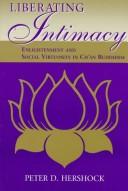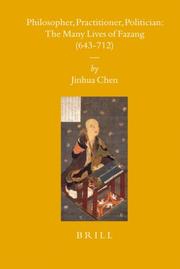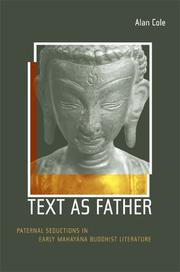| Listing 1 - 10 of 15 | << page >> |
Sort by
|
Book
ISBN: 9780231552677 023155267X 9780231198523 9780231198530 Year: 2020 Publisher: New York, NY
Abstract | Keywords | Export | Availability | Bookmark
 Loading...
Loading...Choose an application
- Reference Manager
- EndNote
- RefWorks (Direct export to RefWorks)
First published in 1981, The Renewal of Buddhism in China broke new ground in the study of Chinese Buddhism. An interdisciplinary study of a Buddhist preacher and reformer in late Ming China, it challenged the conventional view that Buddhism had reached its height under the Tang dynasty (618–907) and steadily declined afterward.Chün-fang Yü details how in sixteenth-century China, Buddhism entered a period of revitalization due in large part to a cohort of innovative monks who sought to transcend sectarian rivalries and doctrinal specialization. She examines the life, work, and teaching of one of the most important of these monks, Zhuhong (1535–1615), a charismatic teacher of lay Buddhists and a successful reformer of monastic Buddhism. Zhuhong’s contributions demonstrate that the late Ming was one of the most creative periods in Chinese intellectual and religious history. Weaving together diverse sources—scriptures, dynastic history, Buddhist chronicles, monks’ biographies, letters, ritual manuals, legal codes, and literature—Yü grounds Buddhism in the reality of Ming society, highlighting distinctive lay Buddhist practices to provide a vivid portrait of lived religion.Since the book was published four decades ago, many have written on the diversity of Buddhist beliefs and practices in the centuries before and after Zhuhong’s time, yet The Renewal of Buddhism in China remains a crucial touchstone for all scholarship on post-Tang Buddhism. This fortieth anniversary edition features updated transliteration, a foreword by Daniel B. Stevenson, and an updated introduction by the author speaking to the ongoing relevance of this classic work.
Buddhism --- Buddhist priests --- History. --- Zhuhong, --- Buddhist History. --- Chinese Buddhism. --- Chu Hung. --- Ming Buddhism. --- Zhu Hong. --- Zhuhong. --- history of China.

ISBN: 0585034214 9780585034218 0791429814 0791429822 1438406592 Year: 1996 Publisher: Albany, NY State University of New York Press
Abstract | Keywords | Export | Availability | Bookmark
 Loading...
Loading...Choose an application
- Reference Manager
- EndNote
- RefWorks (Direct export to RefWorks)
Zen Buddhism --- Spiritual life --- Religion --- Philosophy & Religion --- Buddhism --- Spiritual life (Zen Buddhism) --- Doctrines. --- Zen Buddhism. --- Doctrines --- S13A/0320 --- China: Religion--Chinese Buddhism: Chan Buddhism (incl. texts)
Book
ISBN: 3839437024 9783839437025 9783837637021 3837637026 Year: 2017 Publisher: Bielefeld
Abstract | Keywords | Export | Availability | Bookmark
 Loading...
Loading...Choose an application
- Reference Manager
- EndNote
- RefWorks (Direct export to RefWorks)
The discourse on transplantation and brain death has become emblematic of conflicts between certain perspectives on adequate medical care, death and dying. Scientific and religious, modernising and traditional as well as academic and popular voices debate on how to approach these topics. This work captures the heterogeneous and often contradictory views on the Malaysian transplant venture and the treatment option of end stage organ failure from the Malay and Chinese population, physicians, state officials, and Muslim, Buddhist and Daoist clergy. It also addresses vital issues as to the use of and extent to which biomedicine and medical technology in contemporary Malaysia actually benefits its people.
Donation of organs, tissues, etc. --- Anatomical gifts --- Organ donation --- Organs (Anatomy) --- Tissue donation --- Tissues --- Donation --- Brain Death; Chinese Buddhism; Islam; Malaysia; Transplantation; Medical Care; Death; Dying; Science; Religion; Politics; Piety; Biomedicine; Medical Technology; Culture; Medicine; Ethnology; Sociology of Medicine; Biopolitics; Body --- Biomedicine. --- Biopolitics. --- Body. --- Chinese Buddhism. --- Culture. --- Death. --- Dying. --- Ethnology. --- Islam. --- Malaysia. --- Medical Care. --- Medical Technology. --- Medicine. --- Piety. --- Politics. --- Religion. --- Science. --- Sociology of Medicine. --- Transplantation.
Book
ISBN: 9780231147309 9780231519700 0231519702 0231147309 9780231147316 0231147317 Year: 2014 Publisher: New York Chichester, England
Abstract | Keywords | Export | Availability | Bookmark
 Loading...
Loading...Choose an application
- Reference Manager
- EndNote
- RefWorks (Direct export to RefWorks)
By establishing a dialogue in which the meditative practices of Buddhism and Christianity speak to the theories of modern philosophy and science, B. Alan Wallace reveals the theoretical similarities underlying these disparate disciplines and their unified approach to making sense of the objective world. Wallace begins by exploring the relationship between Christian and Buddhist meditative practices. He outlines a sequence of meditations the reader can undertake, showing that, though Buddhism and Christianity differ in their belief systems, their methods of cognitive inquiry provide similar ins
Meditation. --- Meditation --- Buddhism. --- Christianity. --- S13A/0200 --- S13A/0360 --- China: Religion--General works --- China: Religion--Chinese Buddhism: ritual and practice (incl. prayers, festivals, ..) --- Dhyāna (Meditation) --- Meditation (Buddhism) --- Meditation (Lamaism) --- Mental prayer --- Prayer, Mental --- Prayer --- Spiritual life --- Contemplation --- Buddhism --- Christianity --- Tantric Buddhism --- Zen Buddhism --- Meditation - Buddhism. --- Meditation - Christianity.

ISBN: 9789004156135 9004156135 9786611920883 1281920886 9047420004 9789047420002 9781281920881 6611920889 Year: 2007 Publisher: Leiden, the Netherlands Boston Brill
Abstract | Keywords | Export | Availability | Bookmark
 Loading...
Loading...Choose an application
- Reference Manager
- EndNote
- RefWorks (Direct export to RefWorks)
The Buddhist monk Fazang (643-712), regarded today mainly as a scholastic monk, was in fact one of the greatest metaphysicians in Asia. This biographical - and hagiographical - study of Fazang seeks to explore his other contributions and in so doing to correct some major mis-presentations and misinterpretations existing in modern scholarship. It highlights and uncovers aspects of Fazang’s complicated life which have been neglected or ignored until now. By experimenting with some methodological innovations in reading medieval Chinese monastic hagio-biography, this study reveals general features, structures and overall governing laws of medieval East Asian monastic hagio-biographic literature. In doing so it is a major contribution to the ongoing discussion among scholars of hagiography in other contexts as well.
S13A/0340 --- China: Religion--Chinese Buddhism: history --- Buddhist priests --- Hua yan Buddhism --- Huayan Buddhism --- Metaphysics --- Priests, Buddhist --- History. --- Fazang, --- Hua-yen Buddhism --- Hwaōn (Sect) --- Kegon (Sect) --- Mahayana Buddhism --- History --- Fa-tsang, --- Hōzō, --- Pŏpchang, --- 法藏, --- 法蔵, --- Xianshou, --- Hsien-shou, --- Hyŏnsu, --- 賢首,
Book
ISBN: 9781438480701 1438480709 9781438480718 9781438480725 1438480717 1438480725 1438480717 Year: 2020 Publisher: Albany, N.Y. Suny Press
Abstract | Keywords | Export | Availability | Bookmark
 Loading...
Loading...Choose an application
- Reference Manager
- EndNote
- RefWorks (Direct export to RefWorks)
Can literature reveal reality? Is philosophical truth a literary artifice? How does the way we think affect what we can know? Buddhism has been grappling with these questions for centuries, and this book attempts to answer them by exploring the relationship between literature and philosophy across the classical and contemporary Buddhist worlds of India, Tibet, China, Japan, Korea, and North America. Written by leading scholars, the book examines literary texts composed over two millennia, ranging in form from lyric verse, narrative poetry, panegyric, hymn, and koan, to novel, hagiography, (secret) autobiography, autofiction, treatise, and sutra, all in sustained conversation with topics in metaphysics, ethics, aesthetics, and the philosophies of mind, language, literature, and religion. Interdisciplinary and cross-cultural, this book deliberately works across and against the boundaries separating three mainstays of humanistic pursuit - literature, philosophy, and religion?by focusing on the multiple relationships at play between content and form in works drawn from a truly diverse range of philosophical schools, literary genres, religious cultures, and historical eras. Overall, the book calls into question the very ways in which we do philosophy, study literature, and think about religious texts. It shows that Buddhist thought provides sophisticated responses to some of the perennial problems regarding how we find, create, and apply meaning - on the page, in the mind, and throughout our lives.
Buddhist literature --- Literature --- Philosophy. --- Indian religions --- Philosophy --- Buddhism --- J5509 --- J1809 --- J1890 --- J1000 --- S13A/0345 --- S37/0600 --- History and criticism --- Japan: Literature -- theory, methodology and philosophy --- Japan: Religion -- Buddhism -- theory, methodology and philosophy --- Japan: Religion -- Buddhism -- literature --- Japan: Philosophy --- China: Religion--Chinese Buddhism: philosophy and theory --- Buddhism outside China, Tibet, Mongolia and Japan--Buddhist philosophy, thought and psychology --- Buddhist literature. --- History and criticism.
Book
ISBN: 0300240511 0300221452 9780300221459 9780300240511 Year: 2018 Publisher: New Haven
Abstract | Keywords | Export | Availability | Bookmark
 Loading...
Loading...Choose an application
- Reference Manager
- EndNote
- RefWorks (Direct export to RefWorks)
An engaging introduction to Zen Buddhism, featuring a new English translation of one of the earliest Zen texts Leading Buddhist scholar Sam van Schaik explores the history and essence of Zen, based on a new translation of one of the earliest surviving collections of teachings by Zen masters. These teachings, titled The Masters and Students of the Lanka, were discovered in a sealed cave on the old Silk Road, in modern Gansu, China, in the early twentieth century. All more than a thousand years old, the manuscripts have sometimes been called the Buddhist Dead Sea Scrolls, and their translation has opened a new window onto the history of Buddhism. Both accessible and illuminating, this book explores the continuities between the ways in which Zen was practiced in ancient times, and how it is practiced today in East Asian countries such as Japan, China, Korea, and Vietnam, as well as in the emerging Western Zen tradition.
Zen Buddhism --- History. --- Zen Buddhism. --- Zen literature --- Zen Buddhist literature --- Buddhist literature --- Chʻan Buddhism --- Dhyāna (Sect) --- Zen --- Zen (Sect) --- Buddhism --- Mahayana Buddhism --- History --- J1880 --- S13A/0320 --- K9076.20 --- Japan: Religion -- Buddhism -- Zen --- China: Religion--Chinese Buddhism: Chan Buddhism (incl. texts) --- Korea: Religion -- Buddhism -- Sŏn (Zen, Chan)
Book
ISBN: 9789004184916 9004184910 9789004204010 9004204016 1283119579 9786613119575 9781283119573 6613119571 Year: 2011 Volume: 24 Publisher: Leiden Boston Brill
Abstract | Keywords | Export | Availability | Bookmark
 Loading...
Loading...Choose an application
- Reference Manager
- EndNote
- RefWorks (Direct export to RefWorks)
In all likelihood, it was the form of Buddhism labeled “Esoteric Buddhism” that had the greatest geographical spread of any form of Buddhism. It left its imprint not only on its native India, but far beyond, on Southeast Asia, Central Asia, including Tibet and Mongolia, as well as the East Asian countries China, Korea and Japan. Not only has Esoteric Buddhism contributed substantially to the development of Buddhism in many cultures, but it also facilitated the transmission of religious art and material culture, science and technology. This volume, the result of an international collaboration of forty scholars, provides a comprehensive resource on Esoteric Buddhism and the Tantras in their Chinese, Korean, and Japanese contexts from the first few centuries of the common era right up to the present. Contributors include: Barbara Ambrose, Anna Andreeva, Sarah Aptilon, Ian Astley, Clemente Beghi, Heather Blair, William Bodiford, Chen Jinhua, Paul Copp, Ronald M. Davidson, Lucia Dolce, Athanasios Drakakis, Donald Drummond, Ruth Dunnell, Jay Ford, David Gardiner, Rolf Giebel, Robert M. Gimello, David Gray, Elizabeth ten Grotenhuis, Nobumi Iyanaga, George Keyworth, Martin Lehnert, Hun Y. Lye, Shinya Mano, Richard M. McBride, Laura Meeks, Regan Murphy, Charles D. Orzech, Richard K. Payne, Klaus Pinte, Fabio Rambelli, Thierry Robouam, James Robson, Brian Ruppert, Neil Schmid, Gaynor Sekimori, Shen Weirong, Henrik H. Sørensen, Mark Unno, Pamela Winfield
Tantric Buddhism --- Bouddhisme tantrique --- Tantras --- Tantras. --- S13A/0315 --- S13A/0310 --- J1876 --- J1873 --- J1800 --- K9076 --- K9070 --- China: Religion--Chinese Buddhism: sects: general --- China: Religion--Buddhism: China --- Japan: Religion -- Buddhism -- Shingon --- Japan: Religion -- Buddhism -- Tendai --- Japan: Religion -- Buddhism -- general and history --- Korea: Religion -- Buddhism -- schools, sects and denominations --- Korea: Religion -- Buddhism -- general and history --- Buddhism, Tantric --- Buddhist tantrism --- Esoteric Buddhism --- Mantrayāna Buddhism --- Mikkyō --- Tantrism, Buddhist --- Vajrayāna Buddhism --- Buddhism --- Mahayana Buddhism --- Mandalas --- Āgamas

ISBN: 1282762877 9786612762871 0520937074 1597348902 9780520937079 1417522739 9781417522736 9780520237971 0520237978 9780520237988 0520237986 0520237978 0520237986 Year: 2004 Publisher: Berkeley, Calif. University of California Press
Abstract | Keywords | Export | Availability | Bookmark
 Loading...
Loading...Choose an application
- Reference Manager
- EndNote
- RefWorks (Direct export to RefWorks)
The tradition of Chan Buddhism-more popularly known as Zen-has been romanticized throughout its history. In this book, John R. McRae shows how modern critical techniques, supported by recent manuscript discoveries, make possible a more skeptical, accurate, and-ultimately-productive assessment of Chan lineages, teaching, fundraising practices, and social organization. Synthesizing twenty years of scholarship, Seeing through Zen offers new, accessible analytic models for the interpretation of Chan spiritual practices and religious history. Writing in a lucid and engaging style, McRae traces the emergence of this Chinese spiritual tradition and its early figureheads, Bodhidharma and the "sixth patriarch" Huineng, through the development of Zen dialogue and koans. In addition to constructing a central narrative for the doctrinal and social evolution of the school, Seeing through Zen examines the religious dynamics behind Chan's use of iconoclastic stories and myths of patriarchal succession. McRae argues that Chinese Chan is fundamentally genealogical, both in its self-understanding as a school of Buddhism and in the very design of its practices of spiritual cultivation. Furthermore, by forgoing the standard idealization of Zen spontaneity, we can gain new insight into the religious vitality of the school as it came to dominate the Chinese religious scene, providing a model for all of East Asia-and the modern world. Ultimately, this book aims to change how we think about Chinese Chan by providing new ways of looking at the tradition.
Zen Buddhism --- Spiritual life --- Life, Spiritual --- Religious life --- Spirituality --- History. --- S13A/0320 --- History --- China: Religion--Chinese Buddhism: Chan Buddhism (incl. texts) --- Bouddhisme zen --- Histoire --- China --- Chine --- Religion --- Zen Buddhism - China - History. --- asian studies. --- bodhidharma. --- buddhist doctrine. --- buddhist social organizations. --- buddhists. --- chan lineages. --- china. --- chinese chan buddhism. --- chinese philosophy. --- comparative religion. --- genealogy. --- huineng. --- koans. --- modern buddhism. --- nonfiction. --- religion and spirituality. --- religious criticism. --- religious historians. --- religious history. --- religious scholars. --- religious studies. --- sixth patriarch. --- spiritual encounters. --- spiritual tradition. --- transformation. --- zen teaching. --- zen.

ISBN: 9786612357589 0520931408 1282357581 1598755412 9780520931404 1417595876 9781417595877 9781598755411 9780520242760 0520242769 9781282357587 6612357584 Year: 2005 Publisher: Berkeley Los Angels University of California Press
Abstract | Keywords | Export | Availability | Bookmark
 Loading...
Loading...Choose an application
- Reference Manager
- EndNote
- RefWorks (Direct export to RefWorks)
This beautifully written work sheds new light on the origins and nature of Mahayana Buddhism with close readings of four well-known texts-the Lotus Sutra, Diamond Sutra, Tathagatagarbha Sutra, and Vimalakirtinirdesa. Treating these sutras as literary works rather than as straightforward philosophic or doctrinal treatises, Alan Cole argues that these writings were carefully sculpted to undermine traditional monastic Buddhism and to gain legitimacy and authority for Mahayana Buddhism as it was veering away from Buddhism's older oral and institutional forms. His sophisticated and sustained analysis of the narrative structures and seductive literary strategies used in these sutras suggests that they were specifically written to encourage devotion to the written word instead of other forms of authority, be they human, institutional, or iconic.
Mahayana Buddhism --- Paternalism --- Parentalism --- Social classes --- Social control --- Social systems --- Doctrines. --- Religious aspects --- Mahayana Buddhism. --- Sacred books. --- Mahayana Buddhism - Sacred books. --- Paternalism - Religious aspects - Mahayana Buddhism. --- Mahayana Buddhism - Doctrines. --- asian. --- buddhism. --- buddhist books. --- buddhist monk. --- buddhist studies. --- china. --- chinese buddhism. --- diamond sutra. --- eastern philosophy. --- eastern religion. --- lotus sutra. --- mahayana. --- meditation. --- mindfulness. --- monastic buddhism. --- monasticism. --- monk. --- nonfiction. --- philosophy. --- religion. --- spirituality. --- sutra studies. --- sutra. --- sutras. --- tathagatagarbha sutra. --- vimalakirti nirdesa.
| Listing 1 - 10 of 15 | << page >> |
Sort by
|

 Search
Search Feedback
Feedback About UniCat
About UniCat  Help
Help News
News